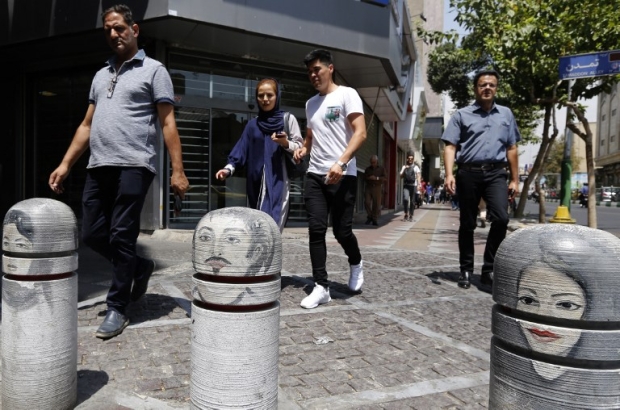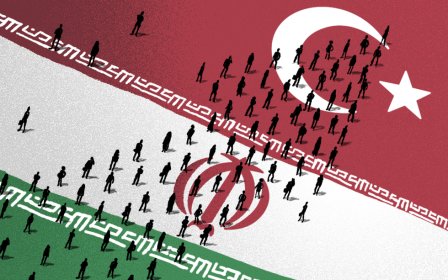Yachts, fast cars and Instagram: Iran's rich kids enrage sanctions-hit citizens

TEHRAN - Parties on yachts. Rides in Lamborghinis. Meals at five-star restaurants.
These are scenes Iranians have grown accustomed to seeing on social media in recent years as Instagram accounts like "The Rich Kids of Tehran" and a line-up of other insta-celebs have gained tens of thousands of followers and fascinated the West.
One of these celebrities – the son of a former Iranian ambassador – told his followers to stop spending time looking at his lavish photos and start figuring out a way to make money.
“How much longer do you want to be jealous of me?” Sasha “Sash” Sobhani posted this summer in a video on Instagram. “If you can’t make money and you can’t live, then you can drop dead. Period.” The post was later deleted, but captured on YouTube.
But now that renewed US sanctions are taking effect, these self-made spectacles of Iran’s one percent are a much harder pill to swallow for young people like 33-year-old Reza Derakhshani.
“It drives me angry when I see Sasha Sobhani or guys like him who have become wealthy as a result of their fathers’ links,” said Derakhshani, a PhD student. “Why should such discrimination exist in this country?"
“I want to marry a girl I love, but I can’t afford to hold a ceremony and then rent a home.”
Everyday life for many Iranians is a struggle right now. The prices of basic goods have skyrocketed after the value of the rial fell by two-thirds earlier this year. Some products, including vital medicines, are hard if not impossible to find.
It drives me angry when I see Sasha Sobhani or guys like him who have become wealthy as a result of their fathers’ links
- Reza Derakhshani, 33, PhD student
The contrast between this world and those of the jene khroub ("good genes" in Farsi) or aghazadeh (an informal term that means the son of an official figure) has reignited long-running frustrations about corruption and the preferential treatment privileged youth receive in the country.
Tehran-based sociologist AmanAllah Qarai Moghadam said the frustrations have helped fuel recent protests.
“The ‘good genes’ are telling ordinary people to drop dead while the origins of their own wealth is unclear,” he said. “If I were in the shoes of the government, I would have arrested and put these people in jail.”
Lives of luxury
The term aghazadeh first caught on in Iran in the 1990s to describe the children of several corrupt officials as rumours about their outrageous behaviour swirled.
Then in 2017, the term jene khroub emerged as another popular term for the same type of nepotism after the son of a prominent reformist politician said in an interview that his success in business was a result of his good genes.
His comments set off a firestorm on social media with Iranians posting all kinds of jokes about "good genes".
Translation: As of tomorrow, the results of the "good genes" test will be added to the documents required for participating in tenders for the mega-governmental projects
But reformist officials aren’t the only ones targeted. The children of hardliners – including Elyas Qalibaf, the son of the three-time conservative presidential candidate – are among those whose source of wealth has been publicly questioned.
While social networks, including Instagram, remain blocked in Iran, the privileged sons and daughters of officials aren’t hard to find even now as the hardship of sanctions settles in. In fact, many prefer to go high-profile.
Sobhani, the son of the former ambassador, is one of these. The 31-year-old, whose real name is Mohammad-Reza, posts photos of himself driving expensive cars, passing time on yachts and partying in tuxedos, all of which have made him one of the most hated faces among ordinary Iranians.
Translation: Only shitting on the face of Sasha Sobhani will calm me
It’s unclear exactly what Sasha, who lives outside of Iran, does for a living, but he has tried to downplay his privilege. When his father was posted in Venezuela, he said he made good friends including former president Hugo Chavez’s son.
“These were all because of my savvy and had nothing to do with this issue that my father was the ambassador,” he said.
Earlier this year, Sobhani’s father all but disowned him publicly. “Mohammad-Reza is my child. But in terms of lifestyle and beliefs, he differs from me, and all of my attempts to direct him to the right path failed,” Ahmad Sobhani told Fars News Agency.
Another set of "good genes" who have grabbed the public’s attention are the son and daughter-in-law of Iran's ambassador to Denmark.
Amir-Mohsen Moradian and his wife, the model Anashid Hosseini, came under fire when pictures of their luxurious wedding ceremony were leaked to Instagram in July. They have since been deleted, but reported about in the media.
The earliest criticism of the wedding came from conservatives and hardliners, who were seeking to discredit the moderate government of Hassan Rouhani.
The public, meanwhile, attacked the couple for their lavish lifestyle.
Translation: Anashid Hosseini, a fashion designer who is achieving the path of [success] overnight. Reason; [she] is the wife of Amir-Hossein Moradian, the Aghazadeh of Iran's ambassador to Denmark
In reaction, the couple posted on Instagram, attempting to explain their lifestyle – but their explanation proved for many as baffling as the leaked wedding photos.
Hosseini said that the dire economic situation has forced her once affluent family into Iran’s middle class, and that brand new purses in photos shared online were fakes. Her husband said he had only spent between $5,000 and $6,000 for their wedding.
Stirring up anger
The images that Sasha Sobhani and the other children share online are so offensive that Iranians their age say they feel that the "good genes" are violating their rights.
Laleh Ghavam graduated from a prominent Iranian university with top grades and a law degree three years ago. She now works as a secretary in a private company.
"I get 2.5 million Toman (around $210 per month), but If I could find a good job related to my major at least in an organisation, I could make a lot more,” she said.
"Unfortunately, the good jobs are given to the good genes, and there is nothing left for us."
Ghavam is not wrong, said Moghadam, the Tehran-based sociologist. “The economy and society are ill … Individuals without specialisation and any efforts are able to earn huge amounts of money only because they have significant links,” he said.
What inspires these Iranians to flaunt their wealth online? One reason, said Moghadam, is that they desire the attention that only their outrageous displays of wealth will bring.
But Albert Boghzian, an economist and a professor at the University of Tehran, suspects there may be more at play. Why, he asks, does the media focus so much on these rich kids?
“These corrupted people have always existed in the country,” he said.
Some of the children of officials may very well be spoiled, but Boghzian said they are being used by the West to bolster anger over growing economic problems in Iran and start a psychological war.
“I think people should be more cautious even while they have true and credible objections to the unequal distribution of wealth,” he said.
Middle East Eye propose une couverture et une analyse indépendantes et incomparables du Moyen-Orient, de l’Afrique du Nord et d’autres régions du monde. Pour en savoir plus sur la reprise de ce contenu et les frais qui s’appliquent, veuillez remplir ce formulaire [en anglais]. Pour en savoir plus sur MEE, cliquez ici [en anglais].







